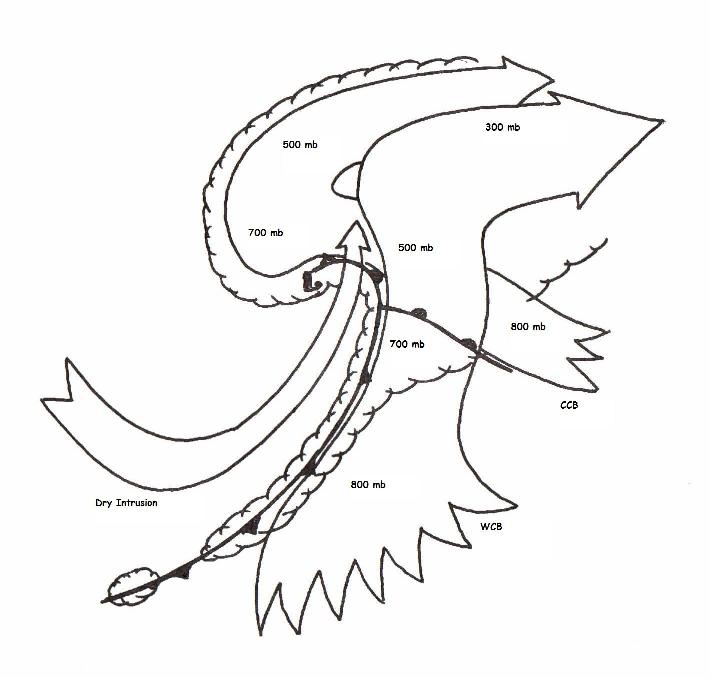 |
| Schematic of a typical conveyor belt pattern. See the text for details. This image was adapted from Figure 9 of Carlson (1980) |
Upon completion of this forecasting topic you will be able to:
One of the best ways to visualize the three-dimensional flow around a mature frontal cyclone is to use the conveyor belt concept. Even though Carlson (1980) first presented the conceptual model in 1980, parts of this concept were developed earlier by Harrold (1973), modified later by Young et al (1987), and summarized by Browning (1999).
This concept was intended to describe the storm-relative flow around a mature frontal wave. Carlson assumed a constant movement of the system to determine the relative motion using isentropic analysis. The image below shows the conveyor belts at one point in time. Please realize these belts change during the life cycle of a cyclone.
 |
| Schematic of a typical conveyor belt pattern. See the text for details. This image was adapted from Figure 9 of Carlson (1980) |
The warm conveyor belt (marked WCB in the figure above) represents the main source of warm, moist air that feeds the cyclone. It originates in the warm sector of the cyclone and flows poleward parallel to the cold front. This layer can be 200 to 300 mb deep and typically begins in the convective mixing layer well away from the low center. As the flow approaches the warm front, it begin to ascend with its strongest rise over the warm front, in the area of strongest warm air advection. It eventually starts to turn anticyclonically as it joins the jet level flow in the upper troposphere. The pressure values in the figure above represent the approximate pressure level of the flow at that point in space.
One representation of the WCB takes a branch of this flow and curves it around the occlusion and cyclonic circulation. This variation is more likely to occur during the later stages of a cyclones life cycle. Browning (1999) referred to the main WCB as W1 and this secondary branch as W2.
The amount of precipitation produced by a cyclone may depend upon the amount of moisture flowing into the circulation along the WCB. During the winter over the Central United States, well-orgainzed lows with strong dynamics move out of the High Plains of Colorado. However, if the WCB is not tapping good moisture, the snowfall may be relatively light compared to what the dynamics support. Nota bene, pay special attention to the amount of moisture that the WCB is feeding into a system as you develop your precipitation forecast.
The cold conveyor belt (marked CCB in the figure above) originates poleward and east of the low pressure center, typically in the westerly flow on the backside of a high pressure system to the east. This air flows westward, on the cold side of the warm front, below the WCB, toward the center of the low pressure circulation. The air becomes saturated through a combination of precipitation falling into the CCB from the WCB above and slow ascent from the boundary layer to the mid-troposphere north of the low center (see figure above). The flow eventually rises and turn anticyclonically into the upper tropospheric ridge ahead of the developing cyclone.
As a cyclone develops there is typically an intrusion of dry air equatorward of the low pressure system between the intensifying surface low center and the cold front (see figure above). This air originates near the tropopause fold or break, descends on the backside of the developing cyclone to mid tropospheric levels, and starts to rise once it is east of the upper trough that is associated with the developing cyclone. This dry air eventually rises over the CCB parallel to the WCB. The penetration of this dry air over the low level moisture creates potential instability that may be released as convective clouds. The dry air intrusion is usually obvious on water vapor imagery.
The flow of air through midlatitude cyclones is important to understanding the cloud and precipitation distribution around the cylcone. The conveyor belt concept helps you visualize this flow pattern. It helps you identify the best area for rising air and precipitation. When applying this concept in actual forecast situations, remember that this model displays "storm-relative" flow and that weather maps display actual wind. Nevertheless, by examining the winds at several levels on your analysis or prognostic charts, you can still get a good feeling for the flow pattern and their source regions. Use the conveyor belt concept to help you visualize what is happening and better understand the current weather situation.
Instructions: Place the cursor over the answer of your choice. If you are correct, it will be highlighted in green; if you are incorrect, it will be highlighted in red.
The primary moisture source for the cyclone's precipitation is associated with the:
The cold conveyor belt originates:
The dry intrusion originates:
Conveyor belt flow is measured relative to the movement of the low pressure center.
Browning, K.A., 1999: Mesoscale aspects of extratropical cyclones: An observational perspective. in Life Cycles of Extratropical Cyclones, American Meteorological Society, Boston, 265-283.
Carlson, T.N., 1980: Airflow through midlatitude cyclones and the comman cloud patterns. Monthly Weather Review, 108, 10, 1498-1509.
Harrold, T.W., 1973: Mechanisms influencing the distribution of precipitation within baroclinic disturbances. Quarterly Journal of the Royal Meteorological Society, 99, 232-251.
Young, M.V., G.A. Monk, and K.A. Browning, 1987: Interpretation of satellite imamgery of a rapidly deepening cyclone. Quarterly Journal of the Royal Meteorological Society, 113, 1089-1115.